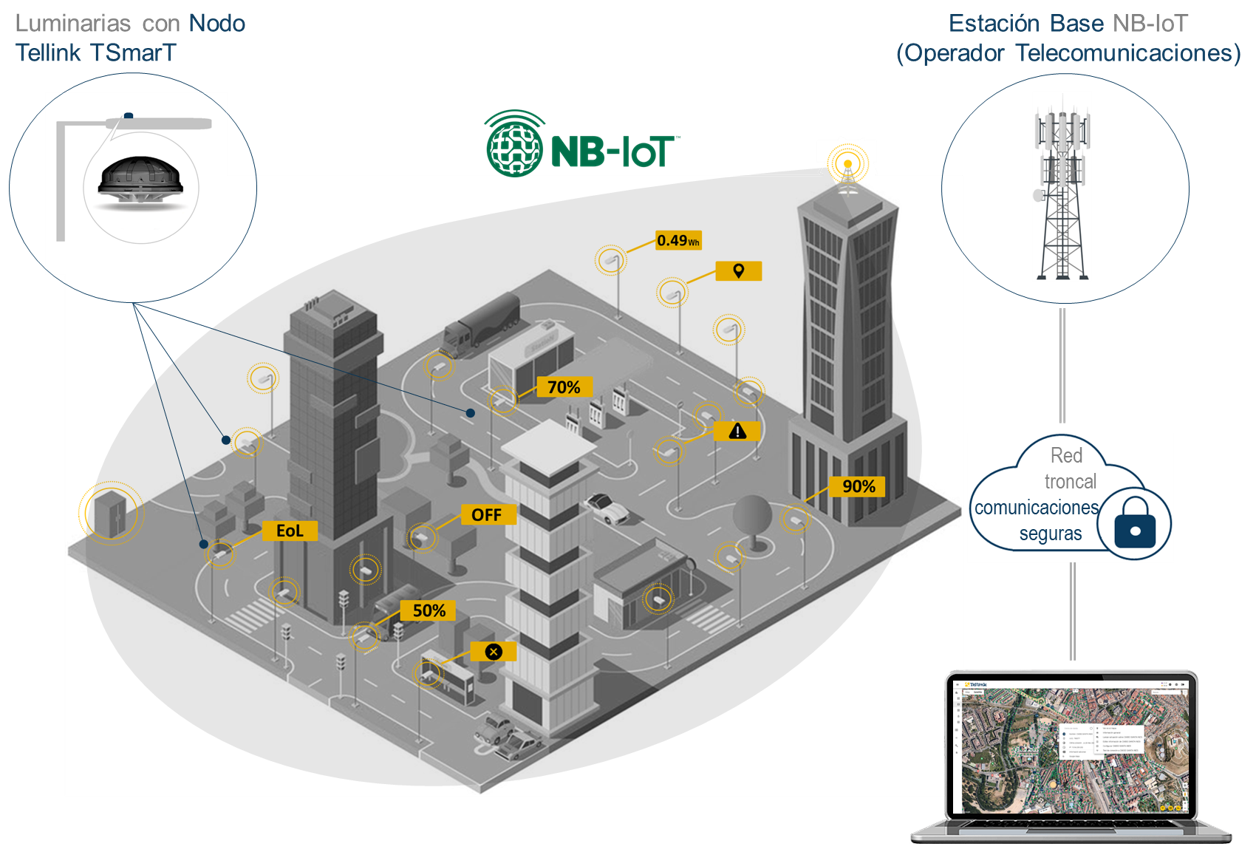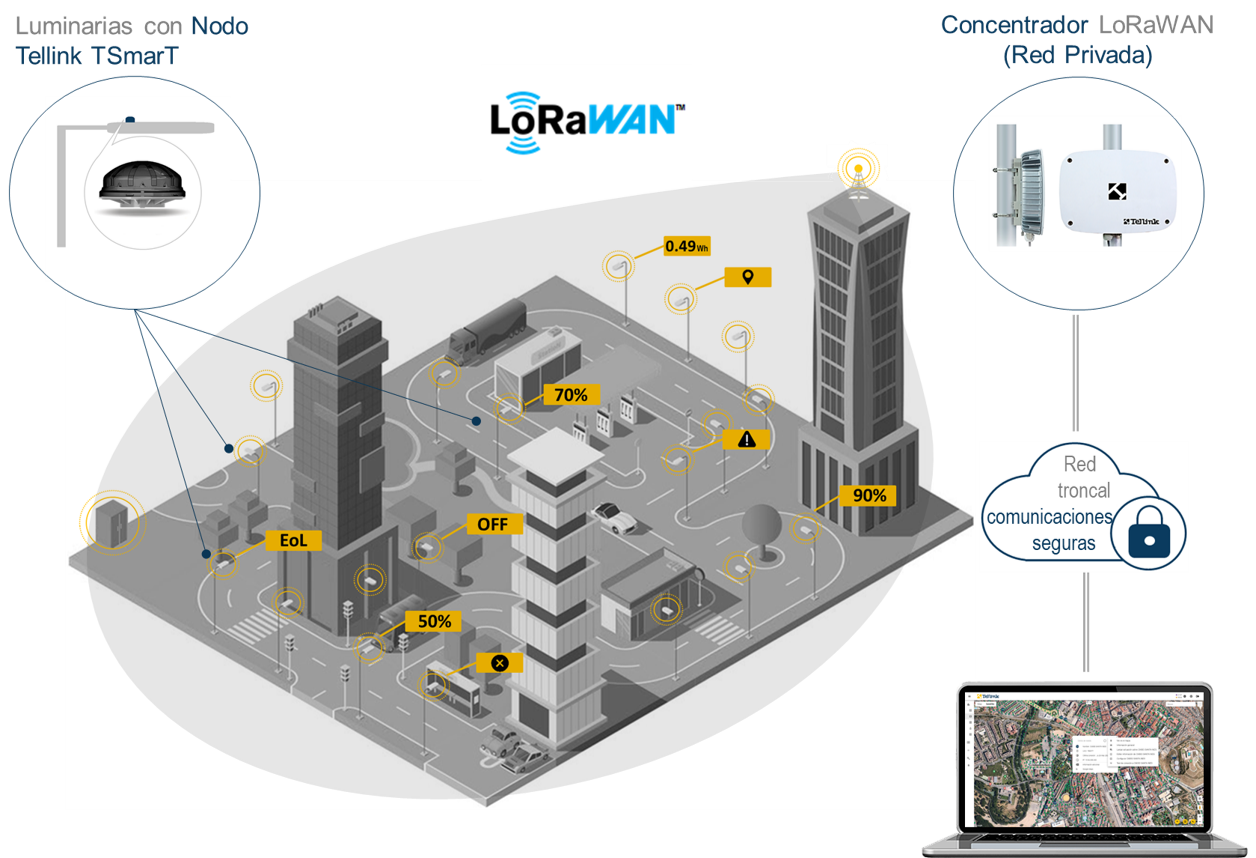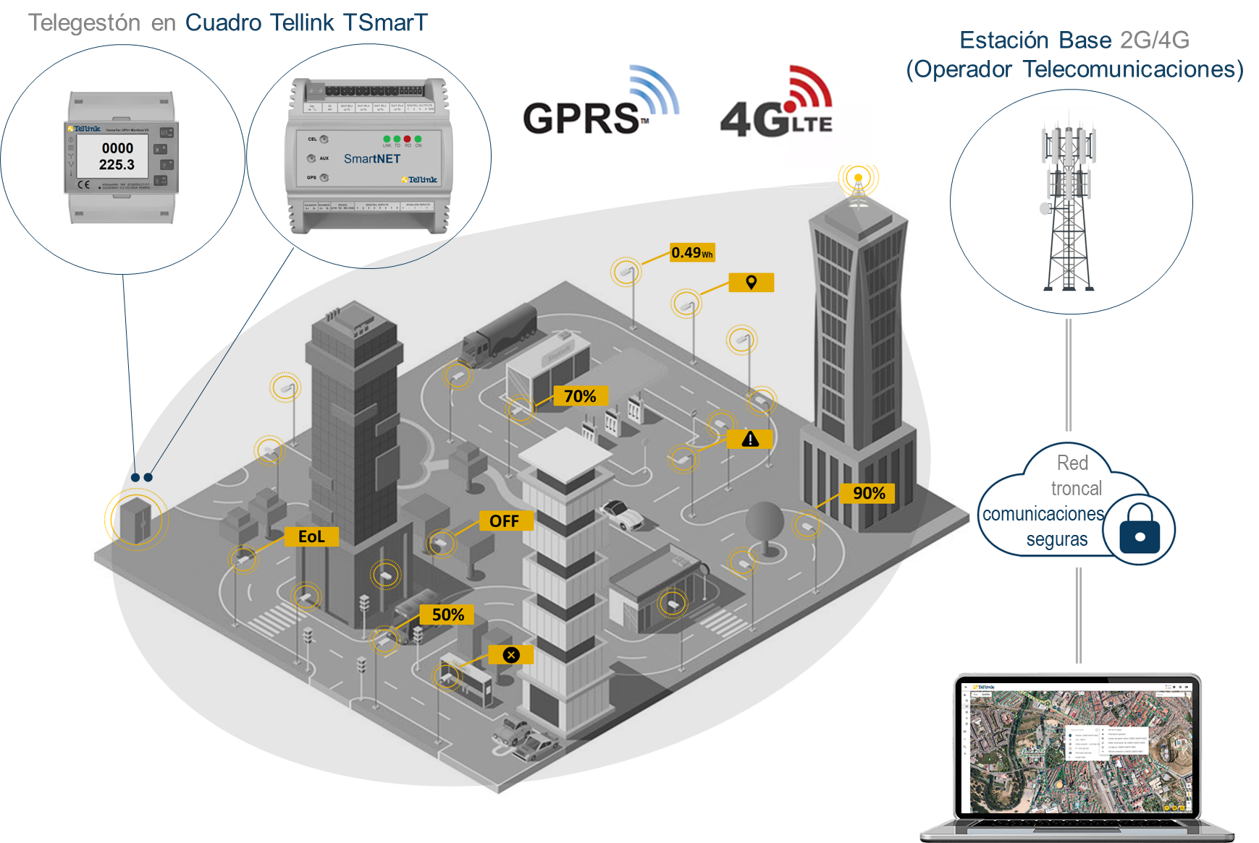New Communication Technologies
For Smart Cities
In an outdoor urban environment, there are thousands of objects that are distributed throughout the municipal area, and many of them do not have access to electrical power. Let's think about an irrigation solenoid valve, a rental bicycle or a waste container.
The communication systems used for connected homes (Zigbee), for smartphones (4G or 5G), or for activity bracelets (Bluetooth or WIFI), were not designed to connect to outdoor municipal objects. , either because its range is very limited and/or its consumption prevents the use of long-lasting batteries. To solve this problem, a new concept is born: LPWAN (Low Power Wide Area Network) networks or technologies. The very name of LPWAN technologies defines their essence: they are next-generation wireless networks (radio) that transmit small amounts of data over long distances, at low cost, and with very low energy consumption, which allows the use of long-lasting batteries for those objects that require it.
The combination of IoT and LPWAN networks represents a revolution for Smart Cities, since they offer for the first time a future solution for the wireless connectivity of objects, in a ubiquitous way, with long-lasting batteries when necessary, and supported by standards world-renowned international companies. Public lighting luminaires are ideal elements for the implementation of these latest generation technologies.
The two most representative LPWAN technologies currently for application in Smart Cities are, without a doubt, NB-IoT© (emerged in 2016) and LoRaWAN© (emerged in 2015) . Both NB-IoT© and LoRaWAN© are supported by international organizations (3GPP and LoRa Alliance), and have extensive ecosystems of companies and developers that guarantee the interoperability of the devices.
The Tellink TSmarT Individual Luminaire Control Nodes are available in several communication alternatives, but NB-IoT and LoRaWAN are the most widespread and without a doubt those preferred by customers, both in massive deployments in large cities and in medium and small municipalities. . The use of one or another communication technology will depend on the type of deployment, the density of connected objects, and the resources available in municipal services. The use cases of NB-IoT and LoRaWAN, as we will see later, are different.
Communications: An Important Decision
The choice of communication technologies to use for connected assets outside municipalities is an important decision, which in most cases determines the success of a deployment. Connected luminaires normally represent the largest subset of connected objects in a municipality, and are regularly distributed throughout the municipality. Any municipality has thousands of lights, and the decision of which communications technology is used to provide them with IoT connectivity, in many cases defines the path to follow for other types of municipal assets (such as waste containers or water meters, among many others).
For new deployments, always recommends the use of latest generation communication technologies to prevent obsolescence, and that are specifically designed to support deployments in open outdoor environments. Below we will review the advantages provided by some of these next-generation networks.
NB-IoT is a type of LPWAN network developed under the specification of 3GPP, an international organization that regulates mobile telecommunications networks worldwide (such as GSM, GPRS, 3G, 4G, 5G, among others). It is a new cellular technology, part of the 5G ecosystem, and that uses exclusive frequency bands.
NB-IoT connectivity is offered as a service by a Telecom operator. Each TSmarT Node will incorporate a SIM card (physical or virtual), with the appropriate data plan. The use of exclusive frequencies and low latency of NB-IoT allows it to offer the highest quality of service currently available.
LoRaWAN is a type of LPWAN network sponsored by the LoRa Alliance, an organization that brings together more than 600 companies. It uses free frequency bands, with no usage cost, but shared by any device that works on them. With exceptions, they are private networks with dedicated Network Concentrators and Servers.
LoRaWAN incorporates mechanisms to minimize interference, however operating in a free band poses a greater risk than if exclusive bands were used. The fact that the private network infrastructure must be maintained by the municipality requires resources whose cost must be assessed before implementation.
Traditional 2G and 4G cellular networks are a specification of 3GPP, an international telecommunications regulatory body, and have been established for years. These networks are the best alternative for communications with the Lighting Command Centers, due to the large amount of information and the high frequency with which it is generated.
Tellink UCCs incorporate the SIM cards of the chosen operator or operators, and with the appropriate data plan for each contract. It should be noted that in some countries the “shutdown” of 2G (GPRS) networks has been announced, which should be taken into account before choosing the appropriate UCC. Tellink has both 2G and dual UCCs (2G+4G).
FAQ
Both NB-IoT and LTE-M (also known as Cat-M1) are next-generation LPWAN (Low Power Wide Area Network) cellular networks, specifically designed to provide IoT (Internet of Things) connectivity. 3GPP is the body that regulates these two standards, and all other cellular communications standards. Both technologies are provided by a telecommunications cellular operator, require a SIM card, and use exclusive frequency bands, in which no one else can transmit signals. However, they are not the same.
LTE-M offers higher communication speeds, allows mobility and voice communications, but the cost of the radio transceivers is higher and the battery life is shorter. For its part, NB-IoT offers a lower speed, it is not designed to connect objects with mobility, but it allows the design of very low-cost devices with longer battery life. Although both technologies are applicable to design Luminaire Controllers, NB-IoT offers advantages. For this reason, most operators in Europe have chosen to deploy NB-IoT networks, while only some opt for LTE-M.
The short answer is yes. Globally, 2G and 3G will disappear in the coming years, and in some countries they have already disappeared. It is inevitable, since the frequencies currently used by 2G and 3G will be necessary for 5G (remember that NB-IoT is part of the 5G ecosystem). Most operators have already announced a specific date for the shutdown of 3G networks. For example, Movistar in Spain will turn off 3G in 2025. Some have also set a date for the turn off of 2G, although later than for 3G, given the high implementation of 2G (GPRS) in the field of industrial M2M. It must be remembered that legacy 2G (GPRS) or 3G modems ARE NOT compatible with 4G, and it would be necessary to replace them in the event of the GPRS networks being turned off.
Those responsible for the projects are recommended to take this circumstance into account when choosing the solutions to install. Tellink has Lighting Remote Management solutions in Panels with 2G modems, and others with dual 2G+4G modems. Tellink always recommends the use of dual 2G+4G systems, to avoid the possible risk of shutting down 2G networks, but the cost is higher. The decision ultimately rests with those responsible for each project.
Streetlighting Cabinets are distributed throughout the municipal area. This circumstance makes unfeasible the installation of wired communication networks. For this reason, practically all streetlighting Cabinets use wireless communication networks (radio) to communicate with the lighting management software platforms.
Among the possible alternatives for wireless communications, subject to international standards, there are basically two options: traditional 2G/4G cellular networks, and new IoT LPWAN (Low Power Wide Access Network) such as NB-IoT or LoraWAN. However, NB-IoT or LoRaWAN networks are not designed to communicate large amounts of information with high frequency, as required by any modern Cabitet Remote Management system, since to use them it would be necessary to limit the volume and frequency of the information reported from the Cabinet.
Therefore, although Tellink has all the options available, the use of 2G (GPRS) or 4G (LTE) cellular networks is recommended for communication with the streeetlighting Cabinets.
Yes, Tellink Cabinet controllers have the capacity to send these types of orders through the power lines themselves. However, Lighting managers should know that this functionality is only available using proprietary communication methods of some LED Drivers and luminaire manufacturers. Therefore, it will only work with LED Drives and/or luminaires that are compatible with these proprietary communication methods. Furthermore, in most cases, communication with the Luminaries is one-way, which means that there is no direct mechanism to know if those orders have actually been received by all the luminaries.
Luminaire controlllers are low-cost devices. In this context, some lighting managers wonder why increase their cost by adding a GPS module if luminaires have a fix position and they do not move. It's a reasonable question.
The truth is that TSmarT Nodes incorporate a precise GPS module for two reasons. Firstly, the GPS module makes the installation of the Nodes “Plug & Play”, that means that they do not require any attention from the installers, with the consequent cost savings since controllers register and geo-position automatically, without human intervention. This cost savings, in many cases, exceeds the cost of the GPS module to be included in the controllers. However, there is a second, even more powerful reason: the GPS module ensures that TSmarT luminaire controllers have highly accurate local date and time at all times, regardless of whether communications with the Platform are operational. This allows Tellink controllers to ensure that an essential service such as Lighting is not interrupted under any circumstances, even if communication systems or application servers are temporarily unavailable. In this way, a TSmarT Node can guarantee the lighting on/off and dimming of the luminaire for years, with a precision of milliseconds even if the communications network or servers are not available.
Consequently, the GPS module could be considered a kind of "life insurance" for the operation of Lighting, with a level of precision infinitely higher than traditional solutions based on real-time clocks, backed by batteries, which suffer inevitable drifts in time.
Both NB-IoT and LoRaWAN are next-generation LPWAN (Low Power Wide Area Network), specifically designed to provide connectivity in the IoT (Internet of Things) world. For open outdoor environments, such as public lighting, they currently represent the best option on the market. However, there are significant differences between the two of them.
NB-IoT connectivity must be provided by a cellular network operator, and it uses exclusive frequency bands, in which no one else can transmit signals. Naturally, this comes at a cost, as each Node must include a SIM card (physical or virtual) with an associated NB-IoT data plan, for which a monthly or annual subscription fee must be paid. Each card has an IP address, which is the most widespread addressing system worldwide. NB-IoT does not require any intermedium Hub/Gateway since luminaire controllers communicate directly with the operator's NB-IoT network.
If LoRaWAN is chosen, on the other hand, we will use free frequency bands, the use of which does not involve a direct cost. However, the client must install and maintain its own private network infrastructure (Network Concentrators, Gateways and Network Servers) which naturally entails a cost that must be considered. Furthermore, using free frequencies has its risks, since anyone can transmit on them as no authorization is required. Therefore, the chance of suffering interferences or reaching spectrum saturation situations exists, as IoT applications become popular and spread. For these reasons, the quality of service that NB-IoT can offer is superior to LoRaWAN. This circumstance must be taken into consideration when planning a very long-term investment (+10 years) such as the renovation of a municipality public lighting infrastructure.
You want to know more?
If you have questions about which communications system best suits your project, or need help to better understand the different options available, do not hesitate to contact us. One of our experts will be happy to answer your question, or even help you throughout the definition phase of your project.


